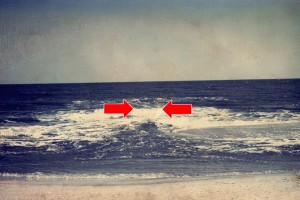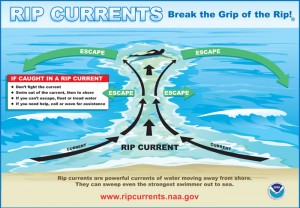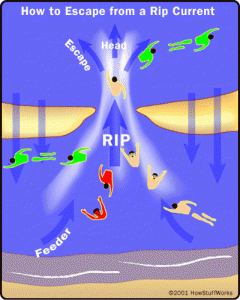How to Avoid and Survive Rip Currents
 Rip currents are channeled currents of water flowing away from shore. They typically extend from the shoreline, through the surf zone, and past the line of breaking waves. Rip currents can occur at any beach with breaking waves, including the great lakes.
Rip currents are channeled currents of water flowing away from shore. They typically extend from the shoreline, through the surf zone, and past the line of breaking waves. Rip currents can occur at any beach with breaking waves, including the great lakes.
Rip currents most typically form at low spots or breaks in sandbars, and also near structures such as groins, jetties and piers. Rip currents can be very narrow or extend in widths to hundreds of yards. The seaward pull of rip currents varies: sometimes the rip current ends just beyond the line of breaking waves, but more powerful rip currents continue to push hundreds of yards offshore.
When Rip Currents
Rip currents can be found on many surf beaches every day. Under most tide and sea conditions the speeds are relatively slow. However, under certain wave, tide, and beach profile conditions the speeds can quickly increase to become dangerous to anyone entering the surf. The strength and speed of a rip current will likely increase as wave height and wave period increase. They are most likely to be dangerous during high surf conditions as the wave height and wave period increase.
Why Rip Currents are Dangerous
Rip currents are the leading surf hazard for all beachgoers. They are particularly dangerous for weak or non-swimmers. Rip current speeds are typically 1-2 feet per second. However, speeds as high as 8 feet per second have been measured–this is faster than an Olympic swimmer can sprint! Thus, rip currents can sweep even the strongest swimmer out to sea.
Over 100 drownings due to rip currents occur every year in the United States. More than 80% of water rescues on surf beaches are due to rip currents.

How to Avoid and Survive Rip Currents
The following tips will help you play at safe.
When at the beach:
Whenever possible, swim at a lifeguard protected beach.
Never swim alone.
Learn how to swim in the surf. It’s not the same as swimming in a pool or lake.
Be cautious at all times, especially when swimming at unguarded beaches. If in doubt, don#’t go out!
Obey all instructions and orders from lifeguards. Lifeguards are trained to identify potential hazards. Ask a lifeguard about the conditions before entering the water. This is part of their job.
Stay at least 100 feet away from piers and jetties. Permanent rip currents often exist along side these structures.
Consider using polarized sunglasses when at the beach. They will help you to spot signatures of rip currents by cutting down glare and reflected sunlight off the ocean’s surface.
Pay especially close attention to children and elderly when at the beach. Even in shallow water, wave action can cause loss of footing.

If caught in a rip current:
Remain calm to conserve energy and think clearly.
Never fight the current.
Think of it like a treadmill that cannot be turned off, of which you need to step to the side.
Swim out of the current in a direction following the shoreline. When out of the current, swim at an angle — away from the current — towards shore.
If you are unable to swim out of the rip current, float or calmly tread water. When out of the current, swim towards shore.
If you are still unable to reach shore, draw attention to yourself by waving your arm and yelling for help.
If you see someone in trouble, don’t become a victim too:
Get help from a lifeguard.
If a lifeguard is not available, have someone call 9-1-1.
Throw the rip current victim something that floats — a lifejacket, a cooler, an inflatable ball.
Yell instructions on how to escape.
Remember, many people drown while trying to save someone else from a rip current.
Also see:
- Sapa Trekking Guide
- Routes for Trekking in Sapa
- TOP THINGS TO DO IN SAPA
- Sapa Travel Guide
- Guide to conquer Fansipan Peak – the “roof of Indochina”?
- Homestay in Sapa – an awesome experience
- Colourful and interesting Markets in Sapa
- Gift to buy in Sapa
- Main Ethnic Minorities in Sapa – Lao Cai
- What to bring for trekking in Sapa
- Sapa Souvenir Shopping
- Train offers good travel options






















